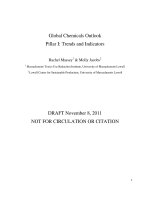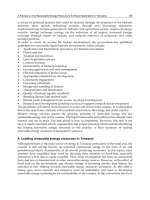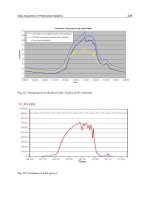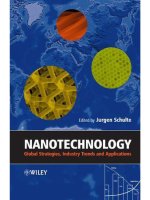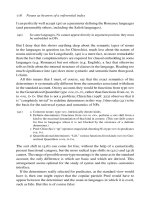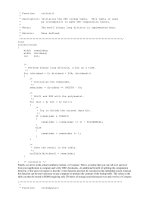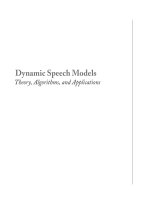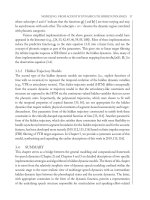Nanotechnology Global Strategies, Industry Trends and Applications phần 5 ppsx
Bạn đang xem bản rút gọn của tài liệu. Xem và tải ngay bản đầy đủ của tài liệu tại đây (246.44 KB, 21 trang )
fibrils, formed in a biological process that might be useful for producing ultra-fine
wires.
TCD is also developing a detailed atomic-level understanding of the methods
used in silicon processing. This should dramatically improve the ability to
control growth and etching of ultra-thin material layers The plan is to develop
new protocols for assembling, fabricating and testing nanometre-scale device
structures, to identify the essential building blocks for nanometre-scale devices,
and to establish predictive rules for the assembly and performance of these
devices.
At University College Galway, a set of spectacles is being developed that can
give ‘super vision’. The approach, termed adaptive optics, uses novel electronics,
computer power and light-sensing devices to improve our view of the world,
and is already being used to enhance the images captured by earth-based tele-
scopes. Here the technique is being employed to get a clearer view of the back of
the retina.
The Irish National Nanofabrication Facility (NNF) was set up at the
National Microscience Research Centre (NMRC) in Cork in 1999 with funding
of s12.7 million from the Higher Education Authority of Ireland. It is the
only such facility in Ireland and Britain and allows university and industrial
researchers access to an R&D platform. Nanotechnology research at NMRC
covers the design, synthesi s, fabrication and characterisation of nanostructures
and nanosystems. The NMRC objectives are to
develop a new understanding of nanoscale phenomena and construct new
nanoscale structures, devices and systems;
use these new nanoscale systems as a tool kit to develop new applications in
science and engineering.
NMRC aims to provide a complete nanotechnology development loop to enable
innovative exploitation of nanosystems specifically within emerging ICT applica-
tion areas, e.g. nanoscale electronics, and at the interface between ICT and other
disciplines, e.g. with photonics (nanophotonics) and with life sciences (nanobio-
technology). One of the SFI-funded projects at the NMRC looks at photonic
software and examines the ways to improve the fundamental understanding of
photonic materials and devices and enable the design of structures for new
capabilities and applications.
The Irish Nanotechnology Association was established in 2002 by Enterprise
Ireland to encourage the development of nanomaterials and processes by Irish
industry. The key objectives are to
make companies aware of the benefits of nanomaterials;
highlight state-of-the-art research ongoing in Ireland and promote technology
transfer from academi a to industry;
Nanotechnology in Europe 65
encourage the development of nanotech companies through spin-offs from the
universities and the institutes of technology;
encourage collaboration between rese archers and industry.
The association is managed by the Materials Ireland Polymer Research Centre, a
programme in advanced technologies (PAT). Visit www.nanotechireland.com/.
3.4.8 Italy
Italian research is excellent in some fields leading to successes in traditional sectors
and in thos e with medium or high technology content, such as instrument
mechanics, robotics, microelectronics, optoelectronics and biomedical technolo-
gies. Italy’s science and tec hnology guidelines include priority areas for nanotech-
nology, intelligent materials and sustainable development and climate change and
governance in a knowledge-based society. Nanotechnologies and material devel-
opment are seen as the key to development of other macro- areas such as instru ment
mechanics, telecommunications, energy, environment, transports, agro-food, health
and cultural heritage. With this is mind, there is a strong emphasis on multisectoral
enabling technologies.
The automotive sector is actively taking up microsystems and nanotechno-
logy for improving car s afety and for catalysts, paints , and structura l and func -
tional materials. In the health sector, nanotechnology is being investigated for
longer-term applications in pharmacy on chips, nanoparticles and gene therapy,
surfaces for medical implants and tissues and organic silicon interfaces.
Minatech is an economic and technological intelligence (ETI) project looking
at trends in micr o- and nanotechnologies and applications and markets for these
technologies.
Italian funding for nanotechnology research almost quadrupled in the period
1997–2000. Funding comes from the Ministry of Scientific Research and the
National Institute for Physics of Matter (INFM) and the National Research Council
(CNR). In the past, CNR funded a national research programme in nanotechnology
(1998–2000), with L8 billion (about £2.5 million pounds, or s4 million) of
government funding. This programme focused on three lines:
nanotechnology and molecular devices for electronics;
nanomaterials and nanodevices for the biomedi cal sector;
nanostructures for other applications.
Participating research groups were located in universities and national research
centres of CNR and the National Energy Research organisation ENEA.
INFM has invested s3 million in a new laboratory in southern Italy at the
University of Lecce dedicated to nanotechnology. Agilent Technologies Inc. and the
University of Lecce have signed a technical cooperation agreement in the field
of inorganic and organic photonic technologies and devices for fibre-optic
66 Nanotechnology
communica tions. The University of Lecce will provide a new laboratory along with
state-of-the-art equipment available in the nanotechnology laboratories, including
metallorganic chemical vapour deposition (MOCVD) reactors, electron-beam
lithography, nanoprocessing, scanning probes and chemical labs. Technical coop-
eration will be developed in
epitaxy of new semiconductor materials for telecommunications,
new-concept nanostructure lasers for telecommunications,
organic materials and technologies for infrared photo nics,
spatially resolved characterisation of devices at the nanoscale.
These materials technologies will be researched by a team of scientists from the
University of Lecce and from Agilent Technologies. The nanotechnology group at
the Engineering Faculty of Lecce was un til now supported by the National Institute
for the Physics of Matter and by the EU.
A new CNR Research Institute in Photonics and Nanotechnology has been
established in Rome, as one of a series of 28 new research institutes. The institute
will carry out research on devices for photonics, optoelectronics, electronics, laser
sources, new materials and characterisation techniques, nanotechnologies and
micro- and nanofabrication.
Italian nanotechnology research is strongly related to biotechnology. The Elba
Foundation, chaired by the biophysicist Professor Claudio Nicolini, is probably the
most internationally visible. This foundation started in 1994 as a follow-up of the
Elba Project, an international collaboration in bioelectronics between Russia and
Italy. This and other Italian research in bioelectronics is coordinated in the National
Bioelectronics Pole (PNB).
3.4.9 Luxembourg
On 31 May 1999 the government of Luxembourg created a National Research
Foundation to distribute R&D funds and develop a national research policy. In June
2001 it published its first activity report. In the first 18 months of operation, it has
organised two cal ls for expressions of interest, which received 50 proposals. From
these it has created four research programmes:
SECOM, on electronic commerce security, for s7.5 million;
NANO, on innovative materials and nanotechnologies, for s6.7 million;
EAU, on sustainable water resource management, for s5 million;
SANTE-BIOTECH, on biotechnology and health, for s6 million.
The NANO programme aims to create a European research centre in characterisa-
tion of materials in the nanometre range. The materials include plastics, metals,
gases, and biological tissues and cells. The Centre will acquire the necessary
instruments, including secondary ion mass spectrometry (SIMS), nanomechanical
surface analysis, and biocompatible measurement methods.
Nanotechnology in Europe 67
3.4.10 Netherlands
The aim of the Dutch ministry of Economic Affairs is to increase the innovative
capacity of the Dutch economy. It is investing about s5 million extra in innovation
in the coming 10 years. Areas for innovation include microsystems technology and
nanotechnology. However, until 2000 there was no national research programme
dedicated to nanotechnology in the Netherlands. Nanotechnology research was
funded through the normal university budgets, from the national research funding
organisations NWO, STW and FOM.
The Foundation for Fundamental Research of Matter (FOM) funds a number of
research programmes related to nanotechnology. The progr amme on nanotechnol-
ogy and nanoelectronics runs from 1998 to 2005 and has a budget of s5.5 million.
The program me on nanostructured optoelectronic materials runs from 1999 until
2003 with a budget of s5.8 million. The programme on single-molecule detection
and nano-optics runs from 1999 until 2004 with a budget of s2.4 million.
Several interdisciplinary research centres are active in nanotechnology. The
most important are Biomade, DIMES and MESAþ. Biomade is a commercial
centre of excellence in molecular (or bio) nanotechnology, related to the Univer-
sity of Groningen’s Biot echnology and Biomedical Research Institute. Opened on
1 January 2000 with a budget of s12 million, it functions as an incubator for
start-up companies. The research is carried out in Biomade, and Applied Nanosys-
tems is responsible for commercialising the patented results. Visit www.biomade.nl/.
The Delft Institute of Microelectronics and Submicrontechnology (DIMES) is one
of the Netherlands’ leading research centres in nanotechnology and related research.
Even though the Dutch government does not have a distinct nanotechnology R&D
programme, it does fund DIMES and some other centres of excellence at universities.
Research in nanoscale electronics and nanoscale structuring is carried out in the
Laboratory for Nanoscale Experiments and Technology (NEXT). DIMES’ annual
budget is around s16 million (£10 million). DIMES also collaborates with estab-
lished companies, including Akzo-Nobel (plastic solar cells), Leica (e-beam litho-
graphy), OptEm and Magma (submicron modelling and extraction). The institute is
experienced in European collaborative R&D projects. At present, it leads the MOSIS
project on micro-optical silicon systems. Visit />The MESAþ research institute at the University of Twente specialises in
microtechnology and materials. It emerged in mid 1999 after a regrouping of the
university’s research in microtechnology and materials. Currently 400 people work
there and it has a budget of s20 million, 50% of which should come from outside
contracts. The Technical University of Eindhoven is installing a new Centre of
Expertise for Nano Devices and Materials Design, in which the university itself is
investing s24 million in the coming 5–10 years. The research builds on existing
expertise in polymers, catalysis and photonics. Wageningen University and
Research Institute, the national knowledge centre in agricultural research, is
actively promoting a collaboration with Biomade and MESAþ in nanotechnology
for agro-applications.
68 Nanotechnology
Dreamstart is a government-funded support organisation that aims to organise
and develop a technostarter and venture capital market in four high-tech fields,
including nanotechnology. It provides an action plan for nanotechnology, claiming
a total government investment in nanotechn ology research and fostering of spin-offs
worth about s107 million in the coming decade. Dreamstart was launched in an
effort to couple entrepreneurialism with the Netherlands’ proven success as a high-
tech business location. During 2003, Dreamstart implemented a promotional
campaign targeting would-be entrepreneurs in the fields of nanotechnology, medical
technology and food technology. Its mission is to improve the quantity and quality
of technology-based start-ups in the Netherlands. In 2002 Dreamstart began
founding start-up incubator facilities in conjunction wi th partner universities.
In 2000 a number of small companies active in development and commercialisa-
tion of micro- and nanotechnologies formed MINAC, the Micro and Nano Cluster.
The goal of MINAC is to enlarge the knowledge and potency of micro- and
nanotechnology for the Netherlands, and for its members in particular, by enabling
its members to join forces.
3.4.11 Poland
KBN, the State Committee for Scientific Research, is a governmental body that was
set up by the Polish parliament on 12 January 1991. It is the supreme authority on
state policy in the area of science and technology. The government’s new economic
strategy clearly defines the preferred fields of scientific research and development.
In accordance with the strategy’s plan, here are the priori ty areas:
biotechnology including genetic engineering,
informatics and telecommunication,
microelectronics and nanotechnologies,
robotisation and automation,
new material technologies.
The European Commission has identified a number of academic centres of
excellence in Polan d. Some of these include expertise relevant for nanotechnology.
The Centre of Molecular and Macromolecular Studies of the Polish Academy of
Sciences (PAS) in Lodz employs about 150 researchers focusing on structural
studies of materials on molecular, macromolecular and supramolecular levels
(
www.cbmm.lodz.pl).
The Institute of Physics of PAS in Warsaw hosts CELDIS, the Centre for Physics
and Fabrication of Low-Dimensional Structures. This consists of 25 laboratories,
and focuses on education and research in solid-state physics, mainly semiconduc-
tors and magnetic materials. The research is targeted to low-dimensional nanometre
structures (
).
The high-pressure research centre UNIPRESS of PAS has world- class high-
pressure equipment for multidisciplinary research, including nanomaterials.
Nanotechnology in Europe 69
(www.unipress.waw.pl). The Institute of Fundamental Technological Research of
PAS hosts a Centre of Excellence in Advanced Materials and Structures
(
www.ippt.gov.pl/amas). The Institute of Biochemistry and Biophysics of PAS in
Warsaw focuses on molecular biology education and research (
www.ibb.waw.pl).
Poland hosts two special ised nanotechnology research networks. FAMA unites
21 Polish partners in research in advanced functional materials. UNIPRESS leads
the international network in interfacial effects of nanostructured materials, invol-
ving 17 partners.
3.4.12 Russia
Support for nanoparticles and nanostructured materials research in Russia and other
countries of the former Soviet Union (FSU) dates back to the mid 1970s. The first
public paper concerning the special properties of nanostructures was published in
Russia in 1976. In 1979 the council of the Russian Academy of Sciences (RAS)
created a section on ultra-dispersed systems. Now research strengths are in the areas
of preparation processes of nanostructured materials, metallurgical research for
special metals and research for nanodevices. Due to funding limitations, character-
isation and utilisation of nanoparticles and nanostructured materials requiring costly
equipment are less advanced than processing techniques.
In 2000 the Russian Federation spent $850 million on research. In Russia the
spending per researcher is only 4% or 5% of the amount spent in the US and Japan.
The US spends 26 times as much on research than Russia, Japan 10 times as much.
The Russian government and international organisations are the primary research
sponsors for nanotechnology in Russia. However, laboratories and companies
privatised in the past few years, such as the Delta Research Institute in Moscow,
are under development. With a relatively lower base in characterisation and
advanced computing, the research focus is on advanced processing and continuum
modelling. Research strengths are in the fields of physico-chemistry; nanostruc-
tured materials; nanoparticle generation and processing methods; applications for
hard materials, purification and the oil industry; and biologically active systems.
Nanotechnology was funded during 1992–2004 under the Physics of Solid State
Nanostructures programme. The associated annual conference series, Nanostruc-
tures: Physics and Technologies, is a prestigious one in Russia. Eleven RAS
institutes and four universities are engaged in 13 nanoprojects in this programme.
Funding for nanotechnology is channelled via the Ministry of Science and
Technology, the Russian Foundation for Fundamental Research, the Academy of
Sciences, the Ministry of Higher Education, and other ministries with specific
targets. The Ministry of Science and Technology funds two national programmes in
nanoscale science: one on surface science and one on nanochemistry. It is presently
developing a new programme in biology.
Since the 1990s, the EU and Russia have collaborated in R&D through
the INCO/Copernicus 2 horizontal programme for international cooperation in
FP5 and INTAS (www.intas.be) for fundamental research. Russian scientists
70 Nanotechnology
from 14 institutes are also engage d in international European COST networks
(www.belspo.be/cost); Russian companies collaborate in 31 projects in EUREKA
(
www.eureka.be). Since 1994 small innovative companies have been supported
through the Russi an Federal Foundation, which assists in the development of small
innovative enterprises (
/fond/welcome1.html). So far it
has supported 400 proposals involving 60 000 people in 500 enterprises.
3.4.13 Spain
There were no specific nanotechnology funding programmes until 2002, when the
funding priority Nanotechnologies, Microtechnologies and Integrated Develop-
ment of Materials was announced as one of 11 strategic research programmes by
the Spanish government. The research plan provides for a large research infras truc-
ture for a multi-p urpose X-ray ultrabrilliant pulsed laser. Funding for research
comes from
the Special Supplementary Fund for Research (FISR),
the Fund for Technological Innovation (FIT–Ministry of Industry),
the Fund for Investments in Basic Research (FIRB).
Non-targeted basic research programme in the current scientific strategy include
particle physics and large accelerators,
construction of the Spani sh line (SPLINE) in the ESRF (already begun),
common elements of the ATLAS and CMS detectors in CERN (already begun).
3.4.14 Sweden
Sweden has one of the highest R&D per capita expenditures in the world, so it is not
surprising that its nanotechnology activities have attracted attention. Nanotechnol-
ogy was taken up relatively early when more than 10 years ago, a research
programme was initiated at the analytical chemistry department of the Royal
Institute of Technology dealing with concepts related to the nanoscale. Similarly,
nanostructure materials research has a long history.
Since 1 January 2001 the Swedish government has restructured its research
system. The General University Fund supports 47% of the total current cost of R&D
in universities. The Swedish Research Council is responsible for funding basic
research in three areas, including natural and engineering sciences. The state and
the business sector collaborate through co-funded industr ial research institutes. The
Knut and Alice Wallenberg Foundation is a private fund that supports expensive
scientific equipment and major scientific programmes. ().
Vinnova is the national innovation support organisation (www.vinnova.se). There
are two major programmes: the Interdisciplinary Materials Research Programme
and the Nanochemistry Programme.
Nanotechnology in Europe 71
The Swedish Foundation for Strategic Research (SSF) is funding a five-year
research programme on nanochemistry, which started in 1999. SSF funding amounts
to SKr 40 million (s4 million) over the five-year period. The programme aims to
develop innovative tools, technologies and methodologies for chemical synthesis,
analysis and biochemical diagnostics, in nanolitre to femtolitre domains. It is open to
scientific as well as industrial collaborations from inside Sweden and the EU.
The foundation also supports a programme at Chalmers University of Technol-
ogy on quantum devices and nanoscience, and a five-year research programme on
nanochemistry at the Division of Analytical Chemistry of the Royal Institute of
Technology in Stockholm. Furthermore, the Swedish research counci ls support
individual projects in nanoscience. The Natural Science Research Council funds
nanostructural materials research, which received s0.8 million in 1998; other
materials research topics received s4 million. The Swedish Research Council for
Engineering Sciences funds similar topics at a level equivalent to about s6.9
million in 1998. SSF funde d ten-year consortia which ended in 2000. These
consortia are being replaced by consortia related to nanotechnology Table (3.1).
The Acreo Institute, owned jointly by an industrial association and a state-owned
holding company, was created in May 1999, based on the former Institute for
Industrial Microelectronics and Institut e of Optical Research. Acreo has centres in
Kista (north of Stockholm), Norrko
¨
ping and Lund. Its mission is to promote
cooperation between the research wor ld and industry so that research results can
be developed and quickly transferred into products and processes for commercial
use. Between 1997 and 2000, Acreo and the Royal Institute of Technology
developed the world’s smallest blood pressure sensor. The sensor is now produced
by the Swedish microelectromechanical systems manufacturer Silex, a spin-off
from Acreo (www.acreo.se/).
With $80 million in funding, MC2, the Microtechnology Centre at Chalmers
University of Technology in Goteborg, Sweden, is leading the way in the
Scandinavian country’s small-tech research. Funding came from the Swedish
Table 3.1 SSF consotia related to nanotechnology
University Topic
Linko
¨
ping University Biomimetic materials science
Uppsala University Quantum materials
Uppsala University Biomimetic enzyme catalysis
Lund University Advanced molecular materials
Linko
¨
ping University Low-temperature thin film synthesis
Royal Institute of Technology Functional ceramics for sensors and IT
Chalmers University of Technology Complex oxide materials for advanced devices
Uppsala University Fundamental research and applications of magnetism
Linko
¨
ping University Quantum wires and dots for optoelectronics
Chalmers University of Technology Carbon-based nanostructures for semiconducting
electronics
72 Nanotechnology
government and private institutions, including the Knut and Alice Wallenberg
Foundation. Chalmers University of Technology also invested in MC2
(www.mc2.chalmers.se). The varied projects blend micro-, bio- and nanotechnol-
ogy and form one of the largest groups under the heading of ‘microtechnology’ at
any university in the world. Projects at MC2 range from microwave electronics to
microelectronics and nanotechnology. Here are some examples:
Research on single-electron transistors, which will lead the way to quantum
computing, where millions of calculations can be made in a single step. Work is
under way on making the first primitive building blocks of a quantum computer.
Working on ways to measure the conductivity of DNA molecules, in the field of
bioelectronics. Research involves studying how molecules and biological speci-
mens can be connected electrically. The group has already produced single-
electron transistors made of molecules in the laboratory. This could lead to using
the self-assembling properties of molecules to build electronic circuits or even
computers.
Bionics research on nanobiotechnol ogy and communication interfaces between
micro- or nanoectronics and biological matter, including living cells. The goal is
to communicate with collections of living neurons. This means using brain
signals, or ‘thought power’, to control electromechanical and electro-optical
devices, and to make a brain understand signals from external sensors.
3.4.15 Switzerland
Switzerland has a well-integrated innovation system including both federal and
cantonal government support. Industries, academia and private R&D have been
focusing on micro- and nanotechnology since the mid 1990s. The federal Ministry
of the Interior is responsible for science and technology, which is coordinated by
the board of the Swiss Federal Institute of Technology, ETH Zu
¨
rich. Switzerland
makes more than SFr 40 million available each year for research in nanotechnology
and related fields. Thus on a per capita basis, Switzerland’s commitment to
nanotechnology is the highest in the world.
The MINAST programme ran from 1996 to 1999, involved SFr 55.6 million of
funding from the federal funding council and ETH Zu
¨
rich and SFr 73 million from
others. National research programme NFP36 in nanosciences ran from 1995 until
1999 and involved 40 research groups. It focused on the study and manipulation of
mesoscopic and molecular systems on a local scale, mainly through scanning probe
methods. Even though Switzerland is not an EU member state, Swiss research
groups are frequent members of EU-funded RTD projects, also in nanotechnology.
Switzerland is also a member of the COST intergovernmental cooperation in
scientific research. EPFL hosts the secretariat of COST action 523 in nanostructured
materials. For the funding period 2 004–2007 ETH Zu
¨
rich is coordinating an ini-
tiative for micro- and nanotechnology worth about SFr 40 million. This is thought
to be sufficient to stimulate further industrial development of nanotechnology.
Nanotechnology in Europe 73
However, it comes at the end of a concerted programme of funding in the area of
nanotechnology.
The main nanotechnology programme in Switzerland is TopNano21, which
ran from January 2000 until the end of 2003, and for more fundamental research
in supramolecular materials there is national research programme NFP47
(www.snf.ch/NFP/NFP47/home_e.html).
TopNano21 aims to develop the knowledge infrastructure to allow dome stic
manufacturers to commercialise nanotechnology. The budget for the years 2000 to
2003 was SFr 62 million. The idea is to support entrepreneurs with marketable
ideas and it is designed to nurture one start-up a month.
The regions Lausanne–Geneva, Neucha
ˆ
tel and Zurich are particularly active in
micro- and nanotechnology. Leading research institutes with an international
standing are CSEM and the Paul Scherrer Institute (PSI). EPFL in Lausanne and
ETH Zu
¨
rich are the federal technological institutes and have a strong nanotechno-
logy research programme. The universities of Fribourg, Basel and Neuchatel colla-
borate, with PSI and the instrument-manufacturing SMEs CSEM and EMPA, which
specialise in organics, ceramics and composites.
ETH Zu
¨
rich has strong research area s in nanotechnology. The Quantum Photo-
nics Institute specialises in quantum wires and dots for applications in quantum
wire light-emitting diodes for optical telecommunication and it has a spin-out
company, BeamE xpress (www.beamexpress.com). There is a research group
focusing on basic properties such as electri cal conductance as well as the mechan-
ical strength of carbon nanotubes. Long-term applications are in new IC chips. The
Centre for Micro and Nanotechnology at the Engineering Science school focuses on
handling nanopowders as well as characterising nanostructured surfaces.
The University of Basel (www.nanoscience.unibas.ch) is the oldest university in
Switzerland. The Institute of Physics specialises on research into image detection,
scanning probes, optics and nuclear physics. It is the home of the scanning
tunnelling microscope, invented by Nobel laureate Gerd Binnig. The National
Competence Network, Nanoscale Science, is coordinated at the University of Basel
and has eight public and private partners. It runs from 2001 to 2011.
PSI is a multidisciplinary natural science and technology research institute
created in 1988 when the Swiss Institute of Nuclear Research was merged
with the Swiss Federal Institute of Reactor Research. It provides a u ser lab for
the international research community in universities and industry, offering
capabilities in basic and applied research. Its core competencies are solid-state
physics, materials sciences, particle physics and astrophysics, life sciences and
nuclear and non-nuclear energy research, proton therapy, and micro- and n ano-
tech research.
The Center Swiss for Electronics and Microtechnology, Inc. (CSEM) is a private
non-profit organisation with 70 shareholders providing access to technologies. It is
supported with long-term contracts provided by the Swiss government designed to
finance applied research. Interested in the future, it looks at new markets and high-
risk technol ogy, generating $100 million with support of spin-offs, and solving
74 Nanotechnology
industrial problems through moving basic research to the applied research stage,
which bridges a gap in commercial product development.
CERN, the European Laboratory for Particle Physics, is the world’s largest
particle physics research centre. Founded in 1954, it was one of Europe’s first joint
ventures and has become a shining example of international collaboration. Some
7000 scientists, half the world’s particle physicists, use CERN’s facilities. EMPA,
the Swiss Federal Laboratories for Materials Testing and Research. consists of a
group of laboratories set up in 1880 for construction materials testing, but not
greatly involved in research. EMPA is now one of the leading researc h institu-
tions involved in sustainable materials and material systems technol ogies. (www.
empa.ch). Research in supramolecular materials is funded through national research
programme NFP47 running until 2004 with a budget of s10 million over five years.
3.4.16 United Kingdom
The UK had an early interest in nanotechnology, with a DTI National Initiative on
Nanotechnology (NION) announced in 1986, followed in 1998 by a four-year LINK
nanotechnology programme. The final tranche of funding for LINK projects was
handed over in 1996. After this time there was no national strategy for nanotech-
nology in the UK, although dispersed research involving nanoscale science
continued to be funded. In 1997 the Institute of Nanotechnology was created to
fill the gap and to act as a focus of interest in nanotechnology. In 2000 the
government White Paper ‘Excellence and Opportunity–A Science and Innovation
Policy for the 21st Century’ identified nanotechnology as a vital new and innovative
area capable of creating new products and new industries. It recognised that the UK
economy could be strengthened by focusing on the research, development and
production of biomedical products based on advances in nanotechnology.
In June 2001 the DTI appointed a nanotechnology expert panel to provide
guidance on nanotechnology policy in the UK. The first action of the panel was to
call for a benchmarking study to be undertaken, to include scenario planning of
possible nanotechnology developments in relation to the UK industrial base over
the next five years. Nanotechnology was identified as one of the priority areas in the
£41 million Basic Technologies programme to provide funding for high-risk
research that may result in some new disruptive technological development. In
addition to the £41 million for research, the government has also introduced a new
£25 million programme over three years aimed at helping businesses commercialise
the key technologies emerging from the Basic Technologies programme. Nano-
technology is also one of the four key rese arch priorities in the third round of
Foresight Link Awards. These awards have a budget of £15 million.
Some £18 million of ring-fenced funds over six years, for two interdisciplinary
research collaborations (IRCs) in nanotechnology, were awarded in 2001 to con-
sortia headed by Oxford and Cambridge Universities. Funds for these collaborations
are bein g made available by three of the government’s research councils (EPSRC,
BBSRC and MRC) plus the Ministry of Defence. It is the UK government’s largest
Nanotechnology in Europe 75
commitment to nanotechnology to date. After six years, the IRCs will revert to
conventional means of support. The IRC in nanobiotechnology is headed by Oxford
University with the Universities of Glasgow and York, and the Medical Research
Council. This collaboration also involves links with the Universities of Cambridge,
Nottingham and Southampton.
The main research themes of the Oxford consortium are
molecular machines,
functional membrane proteins,
bionanoelectronics and photonics,
single-molecule experimental techniques.
The Cambridge IRC will concentrate on the physics of nanotechnology and will
focus on the general theme of fabrication and organisation of molecular structures.
Further government funding partly supports a high-technology cluster develop-
ment initiative to build on activity in nanoscale science and technology at the five
universities in north-east England, and includes funding from the private sector and
the regional development agency One NorthEast. The regional portfolio includes
surface engineering (Northumbria), chemical and biological sensors (Sunderland
and Teesside), molecular electronics (Durham) and biomedical nanotechnology
(Newcastle). Together with the International Centre for Life in Newcastle, which
services the biotechnology sector, the University Innovation Centre for Nanotech-
nology will act as a cross-sector driver for regional high-technology cluster
development.
The Institute of Nanotechnology is the prima ry source of information on
nanotechnology across Europe, and is the lead partner in a £2.7 million European
Network Nanoforum. EUSPEN, the European Society for Precision Engineering
and Nanotechnology, is based at Cranfield and brings together the academic and
industrial community working on ultraprecision engineering. Its aim is to dissemi-
nate expertise, future requirements and emerging technologies in ultraprecision
engineering, nanometrology and precision metrology, and nanotechnology.
The National Physical Laboratory (NPL) is a world-class centre for nanometrol-
ogy. It has been involved in nanotechnology since being the coordinator of the UK’s
National Initiative on Nanotechnology (NION) in 1986. NPL also undertakes a
wide range of relevant research relating to many aspects of nanotechnology,
including basic science; the production of components with nanofeatures, their
characterisation and performance evaluation.
The University of Birmingham has launched I2Nano NanoTech Centre as the first
phase of a vision to establish the West Midlands as a global force in the commercial
exploitation of nanotechnology. The centre will link industrial companies to the
nanoengineering research of the university and its partners, which covers a diverse
multidisciplinary portfolio, based on the twin themes of nanoparticles and nano-
systems. The venture is supported by the regional development agency Advantage
West Midlands, Birmingham City Council and industry as part of a regeneration
76 Nanotechnology
strategy along the A38 Science Corridor. Current partners have already established
nanotechnology groups, including QinetiQ, the Central Laboratory of the Research
Councils (CCLRC), AstraZeneca, SKB, Queen Mary College and the DTI. Building
on total university nanotechnology grants in excess of £11 million, including
participation in a £2.2 million ACORN project, it is anticipated that the centre
will be supported through private and public finance.
CCLRC at Daresbury runs an X-ray photoelectron spectroscopy (XPS) service
for UK university users to carry out surface analysis related to a wide range of
materials science research programmes. CCLRC at the Rutherford Appleton
Laboratory (RAL) has micro- and nanofabrication facilities housed in more than
1200 m
2
of class 10 and class 300 clean rooms in its Central Microstructure Facility
(CMF). CMF also has a wide range of state-of-the-art equipment for high-resolution
pattern definition and pattern transfer, including electron and optical lithography,
deposition and plasma dry etching systems. Nanostructure metrology is routinely
carried out using a field emission SEM (Hitachi S4000) at the facility.
Nanotechnology in Europe 77
4
The Vision and Strategy of the
US National Nanotechnology
Initiative
M. C. Roco
US National Science Foundation
4.1 Motivation
Nanotechnology has opened an era of scientific convergence and technologi-
cal integration with the promise of broad societal implications. The National
Nanotechnology Initi ative (NNI) is a long-term visionary program announced
in January 2000 that coordinates 22 departments and independent agencies with
a total budget of $961 million in fiscal year 2004. This chapter briefly outlines the
motivation of this major investment and the key transforming strategies for its
implementation. As government investments worldwide approach $4 billion, expec-
tations of nanotechnology commercialization and other potential benefits are raised,
and concerns about unexpected societal implications need to be answered to the
public’s satisfaction. Nanotechnology has evolved into a field of broad international
interest, increasing collaboration and stimulating competition.
We know more about single atoms and molecules at one end, and on the bulk beha-
vior of materials and systems at the other end. We know less about the intermediate
length scale, the nanoscale, which is the natural threshold where all li ving systems and
man-made systems work. This is the scale where the first lev el of or ganization of molec-
ules and atoms into nanocrystals, nanotubes, nanobiomotors, etc., is established. The
Nanotechnology: Global Strategies, Industry Trends and Applications Edited by J. Schulte
# 2005 John Wiley & Sons, Ltd ISBN: 0-470-85400-6 (HB)
basic properties and functions of material structures and systems are defined here and,
even more importantly, can be changed as a function of the organization of matter via
atomistic and/or ‘weak’ molecular interactions (such as hydrogen bonds, electrostatic
dipoles, van der Waals forces, various surface forces, electrofluidic forces, and DNA
assembling). This intermediate length scale, where the role of individual atoms and
molecules is measurable and where electrons change their behavior from particle to
wave, is increasingly pervasive. At this scale, there is a unity in the scientific treat-
ment in various disciplines and for various areas of relevance, and we are searching
for unifying concepts. The intellectual drive towards smaller dimensions, which was
essentially enhanced by the discovery of size-dependent novel properties and
phenomena, has been the initial drive towards nanoscience. Only since 1981 have
we been able to measure the size of an atom cluster on a surface (IBM, Zurich). Ten
years later, in 1991, we were able to move atoms on surfaces (IBM, Almaden). After
other ten years, in 2002, we assembled the molecules by physically positioning the
component atoms. We are still at the beginning of this fertile road of scientific
breakthroughs, and nanotechnology is extending the frontiers of knowledge.
The second main reason why nanotechnology has received increased attention in
the past few years is the promise of significant societal implications, which include
better understanding of nature, efficient manufacturing techniques for almost every
human-made object and a new world of products beyond what has been possible
with other technologies, molecular medicine, and sustainable development with a
cleaner environment and efficient energy conversion. In 1999 we projected that $1
trillion in products worldwide will be affected by nanotechnology by 2015; that
would need 2 million nanotechnology workers (Roco and Bainbridge 2001). We
have begun not only to see and touch matter at the nanoscale, but also to uncover
new phenomena and envision manufacturing processes. The experimental tools and
modeling techniq ues are closing the gap between individual atoms and molecules
and the microscale. Once the new behavior has been uncovered at the nanoscale and
the ability to manipulate the matter under cont rol at that scale has been tested, the
importance of the nanoscale becomes evident.
The promising timeline for the beginning of industrial prototyping and commer-
cialization is the third main reason. The first generation of ‘passive nanostructures’
applied in coatings, nanoparticles, and bulk materials (nanostructured metals, poly-
mers, and ceramics) have already entered commercial markets, and we are advancing
toward systematic design methods. The second generation of ‘active nanostructures’
such as transistors, amplifiers, targeted drugs and chemicals, actuators, and adapt ive
structures will be on the same path about five years later (about 2005). The third
generation of ‘systems of nanosystems’ with three-dimensional features, hetero-
geneous nanocomponents and specific assembly techniques (such as bio-assembly,
networking at the nanoscale, hierarchical integration, and new architectures) is
estimated to first reach the commercial prototype stage in about 2010. A fourth
generation, of ‘molecular nanosystems’ with heterogeneous molecules, based on
macromolecules as nanodevices, biomimetics and new molecular designs is
estimated to reach an initial phase of prototype development in about 2020.
80 Nanotechnology
4.2 Government Investment
Table 4.1 tracks nanotechnology government investment around the world since 1997
(Siegel et al. 1999) by using the NNI definition of nanotechnology (Roco et al. 2000;
www.nsf.gov/nano; ). Nanotechnology is working – measuring, mani-
pulating and controlling – at the atomic, molecular and supramolecular levels, at a
length scale of approximately 1 –100 nm, in order to understand and create materials,
devices, and systems with fundamentally new properties and functions because of their
small structure. The NNI d efi nition encourages contributions that were not possible
before: exploiting specific phenomena, properties, and functions at the nanoscale,
which are nonscalable outside of the nanometer domain; and an ability to change
those properties and functions at the larger length scales by manipulation of matter at
the nanoscale. Microelectromechanical systems (MEMS) and other microtechnologies
are complementary to nanotechnology and have not been included in the survey
except for those with nanoscale components. Virtually all industrialized countries
have in development or have established a plan at the national level in recent years.
There are good international opportunities for win-win agreements in the precompe-
titive research areas. The levels of nanotechnology government investment in Europe,
Japan, the US, and other countries in 2004 have increased more than eightfold in the
six years since 1997.
The White House’ s National Science and Technology Committee established in Octo-
ber 1998 the Interagency Working Group on Nanoscience, Engineering, and Technology
(IWGN) with the role of preparing a national program, and replaced it with the Subcom-
mittee on Nanoscale Science, Engineering and Technology (NSET) in July 2000 in order
to implement the NNI (Figure 4.1). Its goals are to facilitate interagency collaboration for
nanoscale R&D, establish R&D priorities and budgets, coordinate planning and program
Table 4.1 Estimated government nanotechnology R&D expenditures in 1997–2004
(estimation in February 2004 in millions of dollars per year)
Region 1997 1998 1999 2000 2001 2002 2003 2004
c
W. Europe 126 151 179 200 $225 $400 $650 $900
Japan 120 135 157 245 $465 $720 $810 $900
USA
a
116 190 255 270 465
b
697
b
862
b
960
Others 70 83 96 110 $380 $550 $800 $900
Total 432 559 687 825 1535 2367 3122 3660
(% of 1997) (100%) (129%) (159%) (191%) (355%) (547%) (722%) (847%)
Notes: W. Europe includes countries in the EU-15 and Switzerland; the rate of exchange is $1 ¼
s1.1 until 2002, s0.9 in 2003 and s0.8 in 2004; yen rate of exchange is $1 ¼ ¥120 until 2002,
¥110 in 2003, ¥1.05 in 2004; Others includes Australia, Canada, China, Eastern Europe, Former
Soviet Union, Israel, Korea, Singapore, Taiwan and other countries with nanotechnology R&D
a
A financial year begins in the US on 1 October of the previous calendar year, six months before
in most other countries
b
The actual budget recorded at the end of the respective fiscal year
c
Preliminary data. Estimates use ‘nanotechnology’ as defined in Roco et al. (2000); this
definition does not include MEMS or microtechnology without nanotechnology components
The US National Nanotechnology Initiative 81
Independent Agencies (11)
CRCD, EPA, FDA,
NASA, NIH,
NIOSH, NRC,
NSF, ITIC, UTO
Independent agencies (11)
CRCD, EPA, FDA,
NASA, NIH,
NIOSH, NRC,
NSF, ITIC, UTO
Departments (10)
DOC / NIST, DOC / USPTO,
DOD, DOE, DOJ,
DOS, DOT,
DOTreas, DHS, USDA
Departments (10)
DOC/NIST, DOC/USPTO,
DOD, DOE, DOJ,
DOS, DOT,
DOTreas, DHS, USDA
NSTC/NSET
Nanoscale Science, Engineering
and Technology Subcommittee
NNCO
, secretariat
NNCO
, secretariat
OMB
OMB
PCAST
PCAST
Industry
Industry
States
States
International
organizations
International
organizations
W
orking
G
roups
W
orking
g
roups
White House/OSTP/CT
Public
Public
Media
Media
CONGRESS
Congress
Academe
Academe
NSET
coordinates NNI
Figure 4.1 Coordination of the US National Nanotechnology Initiative (NNI): OSTP ¼
Office of Science and Technology Policy, NSTC ¼ National Science and Technology
Council, CT ¼ Committee on Technology, OMB ¼ Office of Management and Budget,
NSET ¼ Nanoscale Science Engineering and Technology (established July 2000), NNCO ¼
National Nanotechnology Coordination Office (established January 2001)
Table 4.2 Contribution of key federal departments and agencies to NNI investment in
million dollars per year: each fiscal year (FY) begins on 1 October of the previous year and
ends on 30 September
Federal Department or Agency FY 2000 FY 2001 FY 2002 FY 2003 FY 2004
actual actual actual actual enacted
National Science Foundation (NSF) 97 150 204 221 254
Department of Defense (DOD) 70 125 224 322 315
Department of Energy (DOE) 58 88 89 134 203
National Institutes of Health (NIH) 32 40 59 78 80
National Institute of Standards and 8 33 77 64 63
technology (NIST)
National Aeronautics and Space 5 22 35 36 37
Administration (NASA)
Environmental Protection Agency (EPA) — 6 6 5 5
Homeland Security (TSA) — — 2 1 1
Department of Agriculture (USDA) — 1.5 0 1 1
Department of Justice (DoJ) — 1.4 1 1 2
Total 270 465 697 862 961
(% of 2000) (100%) (172%) (258%) (319%) (356%)
82 Nanotechnology
implementation, as well as e v aluate the NNI to ensure a b road and balanced initiative. The
Subcommittee is composed of representati v es from agencies and White House officials
with interest in the NNI. The Presidential Council of Advisors in Science and Technology
(PCAST) pro vides advice on NNI.
The actual US NNI budget in fiscal year (FY) 2003 was $862 million and the
current plan in FY 2004 is $961 million (Table 4.2). The budget decreases in the FY
2004 request noted at NASA and DOD may be explained by the reassignment
of applied nanotechnology projects to the respective areas of relevance instead of
NNI. State and local organizations com mitted additional funds for infrastructure,
education, and commercialization of more than half of the NNI investment in 2003.
4.3 Transforming Strategy
The main goal of NNI is to fully take advantage of this new technology by a
coordinated and timely investment in ideas, people, and tools. NSET has developed
a coherent approach for funding the critical areas of nanoscale science and engine-
ering, establishing a balanced and flexible infrastructure, educating and training the
necessary workforce, supporting manufacturing and technological innovation lead-
ing to potential economic commercialization, promoting partnerships, and avoiding
unnecessary duplication of efforts. Here are the key investment strategies.
4.3.1 Focus on Fundamental Research
NNI aims for ‘horizontal’ interdisciplinary knowledge creation using the same
principles, phenomena, tools, and structure architectures in the various areas of
relevance. This is combined with ‘vertical’ transition from basic concepts to techno-
logical innovation (Figure 4.2). Nanoscale researc h is advanced in conjunction with
Fundamental research at the nanoscale
Knowledge creation: same principles, phenomena, tools
Basic discoveries and new areas of relevance
M
A
T
E
R
I
A
L
S
E
N
V
I
R
O
N
M
E
N
T
E
L
E
C
T
R
O
N
I
C
S
M
A
N
U
F
A
C
T
U
R
I
N
G
C
B
R
E
S
E
C
U
R
I
T
Y
H
E
A
L
T
H
C
A
R
E
M
I
C
R
O
C
R
A
F
T
I
N
S
T
R
U
M
E
N
T
S
E
N
E
R
G
Y
Revolutionary Technologies and Products
Grand
challenges
Figure 4.2 Interdisciplinary, or horizontal, knowledge creation versus vertical transition
from basic concepts to grand challenges
The US National Nanotechnology Initiative 83
modern biology, the digital revolution, and cognitive and system sciences, which
synergistically support each other and significantly accelerate the overall pace of
discoveries and innovations. NNI supports over 2500 active R&D projects in 2004.
About 65% of funds go to universities, 25% to government laboratories, and about
10% to the private sector (7% is for small business support on a competitive basis
and 3% is for larger organizations).
Nanoscale science and engineering research is intrinsically interdisciplinary and
defined by unifying concepts, but it is performed either in an academic environment
that rewards primarily individual performance, or in an industrial environment
focused on an area of application. Creative approaches are envisioned in order to
change the focus from a single discipline to a system approach and from single to
multiple areas of relevance.
4.3.2 Long-Term Vision of NNI R&D As Part of a Coherent
Science and Technology Strategy
NNI recognizes the importance of visionary, macroscale management measures for
the overall success of the ini tiative. The goals are set for the long term (such as a
decade out), and then working backwards, the future R&D needs for each year are
identified. The ten-year vision is revisited every five years, with program planning
each year, and organizationa l measures for the implementation of the program each
month (Figure 4.3). This is applied by considering various components of the
architecture of contributing factors. It includes defining the vision of nanotechnol-
ogy and NNI goals, establishing the R&D priorities and interagency implementa-
tion plan, integrating short-term technologic al developments into the broader loop
of long-term R&D opportunities and societal implications, using peer review for NNI,
developing a suitable legal framework, and integrating some intern ational efforts.
First, we have established a vision that is focused more on the novel phenom-
enological and system behavior and manufacturability at the nanoscale and less on
the advantages of smallness itself. Work done under the US National Science and
Technology Council (NSTC) has allowed us to effectively address such broader
issues. A ‘bio-inspired’ funding approach of the major NNI research areas has been
adopted: agencies issue solicitations for proposals for relatively broad R&D themes
according to their mission, and then researchers respond with specific ideas in their
proposals in a manner suggesting ‘bottom-up’ assembly of each theme.
It is estimated that in 2001–5 we are at the beginning of the fast-rising sector of
the classical S-shaped development curve where the rate of discovery is increasing.
Overall, the long-term NNI research strategy in the interval 2001–5 is balanced
across five kinds of activity: fundamental research, grand chal lenges, centers and
networks of excellence, research infrastructure, as well as ethical, legal and social
implications and workforce programs. Grand challenges are areas where potential
breakthroughs could provide major, broad-based economic benefits, as well as
dramatically improve the quality of life.
84 Nanotechnology
FY
2001
10 yr
vision
1999
FY
2002
FY
2003
10 yr
vision
2004
Monthly
update of
implementation
(NSET meetings)
FY
2004
FY
2005
FY
2006
FY
2007
FY
2008
10 yr
vision
2009
Annual planning
(NSET, agencies,
OMB, WH,
Congress)
Strategic plan,
renewed every 5
years
(NSET, agencies)
Figure 4.3 Three scales for NNI planning and implementation: 10 years, 1 year and 1 month
